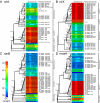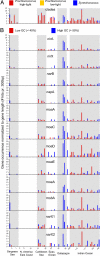Widespread metabolic potential for nitrite and nitrate assimilation among Prochlorococcus ecotypes
- PMID: 19549842
- PMCID: PMC2705535
- DOI: 10.1073/pnas.0902532106
Widespread metabolic potential for nitrite and nitrate assimilation among Prochlorococcus ecotypes
Abstract
The marine cyanobacterium Prochlorococcus is the most abundant photosynthetic organism in oligotrophic regions of the oceans. The inability to assimilate nitrate is considered an important factor underlying the distribution of Prochlorococcus, and thought to explain, in part, low abundance of Prochlorococcus in coastal, temperate, and upwelling zones. Here, we describe the widespread occurrence of a genomic island containing nitrite and nitrate assimilation genes in uncultured Prochlorococcus cells from marine surface waters. These genes are characterized by low GC content, form a separate phylogenetic clade most closely related to marine Synechococcus, and are located in a different genomic region compared with an orthologous cluster found in marine Synechococcus strains. This sequence distinction suggests that these genes were not transferred recently from Synechococcus. We demonstrate that the nitrogen assimilation genes encode functional proteins and are expressed in the ocean. Also, we find that their relative occurrence is higher in the Caribbean Sea and Indian Ocean compared with the Sargasso Sea and Eastern Pacific Ocean, which may be related to the nitrogen availability in each region. Our data suggest that the ability to assimilate nitrite and nitrate is associated with microdiverse lineages within high- and low-light (LL) adapted Prochlorococcus ecotypes. It challenges 2 long-held assumptions that (i) Prochlorococcus cannot assimilate nitrate, and (ii) only LL adapted ecotypes can use nitrite. The potential for previously unrecognized productivity by Prochlorococcus in the presence of oxidized nitrogen species has implications for understanding the biogeography of Prochlorococcus and its role in the oceanic carbon and nitrogen cycles.
Conflict of interest statement
The authors declare no conflict of interest.
Figures



Comment in
-
Prochlorococcus: approved for export.Proc Natl Acad Sci U S A. 2009 Jun 30;106(26):10400-1. doi: 10.1073/pnas.0905187106. Epub 2009 Jun 24. Proc Natl Acad Sci U S A. 2009. PMID: 19553202 Free PMC article. No abstract available.
References
-
- Field CB, Behrenfeld MJ, Randerson JT, Falkowski P. Primary production of the biosphere: Integrating terrestrial and oceanic components. Science. 1998;281:237–240. - PubMed
-
- Dugdale RC, Goering JJ. Uptake of new and regenerated forms of nitrogen in primary productivity. Limnol Oceanogr. 1967;12:196–206.
-
- Moore JK, Doney SC, Kleypas JA, Glover DM, Fung IY. An intermediate complexity marine ecosystem model for the global domain. Deep Sea Res (II Top Stud Oceanogr) 2002;49:403–462.
-
- Liu H, et al. Prochlorococcus and Synechococcus growth rates and contributions to production in the Arabian Sea during the 1995 Southwest and Northeast Monsoons. Deep Sea Res (II Top Stud Oceanogr) 1998;45:2327–2352.
-
- Moore LR, Rocap G, Chisholm SW. Physiology and molecular phylogeny of coexisting Prochlorococcus ecotypes. Nature. 1998;393:464–467. - PubMed
Publication types
MeSH terms
Substances
LinkOut - more resources
Full Text Sources
Miscellaneous

